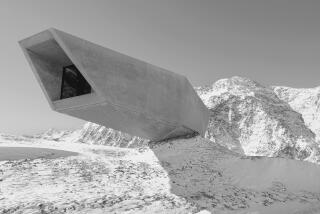Netflix bets on a new design series — and architect Bjarke Ingels
- Share via
“I never dream about my buildings,” Bjarke Ingels says in one episode of “Abstract: The Art of Design,” an eight-part documentary series from Netflix premiering Friday.
That may be because he’s too busy designing the next two or three. Or 20. At the time the episode on Ingels was being filmed about a year ago, his firm, Bjarke Ingels Group, had completed only a dozen projects — still a sizable number for a firm on the rise — but had a remarkable 17 under construction.
And these are not modest buildings: The firm’s clients include Google, the Smithsonian and the chief developer at the World Trade Center site, Larry Silverstein. Ingels’ only Los Angeles commission, for a block-long site along the L.A. River, is a $2-billion behemoth unveiled at the end of last year that would include nearly 800,000 square feet of office space, 250 apartments and two hotels.
That Ingels also found time to accommodate a documentary film crew in the middle of that period, just as he is taking on that almost absurdly wide global portfolio, probably explains his career trajectory as succinctly as any other anecdote you could tell about him.
On the whole the series represents a major bet by Netflix that architecture and design are not daunting high-culture subjects but accessible ones that will play well on the small screen — perhaps the most ambitious bet of that kind since PBS hired architect Robert A.M. Stern to host a series called “Pride of Place” in 1986. (It also had eight episodes.)
The fascinating subtext of the episode on Ingels — the only one in the series dedicated to an architect — is that the 42-year-old is at the moment to his profession almost exactly what Netflix is to Hollywood. “Abstract” was made in the middle of Netflix’s headlong dive into producing its own content, an ambitious roster of movies and series that includes “Narcos,” “House of Cards,” “13th,” “Daredevil,” “Stranger Things” and quite a few more.
In that sense the questions that journalist Andrew Rice raises in “Abstract” about Ingels could well be asked about the new Netflix too. “Is he doing too many projects at once? Is he spread too thin? If you’re the architect who says yes to everything, to every commission, do you at some point have to make compromises in your vision?”
Ingels, for his part, doesn’t apologize for the voraciousness with which he vacuums up jobs and adds staff — nor for what Rice calls his “aesthetic promiscuity.” This is an architect who called his first book, a winning hybrid of monograph and graphic novel, “Yes Is More.”
SIGN UP for the free Essential Arts & Culture newsletter »
Most of Ingels’ finished buildings are in his native Denmark. The only one I’ve seen in person is the apartment complex he designed on the West Side of Manhattan called VIA West 57. (It makes an appearance in “Abstract.”) As a concept it’s brilliant: Ingels set out to marry the midrise courtyard apartment form common in Europe with the midtown skyscraper, and so he pulled up one edge of the building to form a sharp peak, a gesture that also gives many of the apartments wide views of the Hudson River.
But there’s also something thin about the finished product. It feels like a built diagram, like a clever idea (OK, a very clever idea) blown up to skyline scale. I’m still more impressed that Ingels got it finished — in Manhattan, no less, the place so many products of architectural ambition have gone to die — than by the architecture itself.
This may be the best way to understand BIG’s work, at least so far. The firm is so effective and indeed efficient at the poles — in the conceptual phase and the execution phase — that it leapfrogs something crucial in the middle, which is precisely where meaningful and memorable architecture tends to get made.
“Abstract,” created in part by former Wired magazine editor Scott Dadich, makes a similar impression over its eight episodes, each of which runs about 45 minutes and profiles an individual designer staring down a major deadline. (In Ingels’ case it’s the design for a summer pavilion on the grounds of London’s Serpentine Gallery.) It is impressive enough to leave you wishing it might have dug deeper and been a shade less boosterish about its subjects. Rice is one of the lone critical voices, one of the few talking heads to break through the generally celebratory tone.
The series gets off to an encouragingly strong start with charming studies of graphic designer Paula Scher and illustrator Christoph Niemann, probably best known for his New Yorker covers. The episode on Niemann, directed by Morgan Neville and structured like one of the illustrator’s 9 a.m.-to-6 p.m. workdays in his Berlin studio, is easily the smartest and most entertaining of the eight.
“Abstract” sags as it moves to the single-named photographer Platon (known for his stark, close-up portraits of actors and world leaders), Air Jordan impresario Tinker Hatfield and Ralph Gilles, head of design for Fiat Chrysler.
These last two are skip-able unless you are some kind of obsessive completist or feel like wallowing in just how far shoe design and car design have fallen over the last generation. If you’re looking for any examination of Nike’s controversial labor history, you’ve come to the wrong place.
After turning to Ingels, the series rebounds at least a bit in its final episodes, on interior designer (and former Elle Décor editor) Ilse Crawford and stage designer Es Devlin, who got her start in the West End and now produces giant stadium sets for Kanye West and Beyoncé.
As I was binge-watching the series, I kept myself entertained in part by imagining that the advice given by one designer in the series was directed at another.
Niemann, for instance, has a lot to say that seems relevant to Ingels at this point in the architect’s career, especially as Niemann discusses his decision a few years ago to leave New York City and return to Berlin, where the rent is lower, the pace is at least a bit slower and he has more room, in many senses of that word, to operate. The result is that he has been able to begin working in what he describes as a deeper and more intense way than had been the case in New York.
“Berlin,” Niemann says, “makes it easy not to think so much about the feasibility of an idea.”
Twitter: @HawthorneLAT
More to Read
The biggest entertainment stories
Get our big stories about Hollywood, film, television, music, arts, culture and more right in your inbox as soon as they publish.
You may occasionally receive promotional content from the Los Angeles Times.











